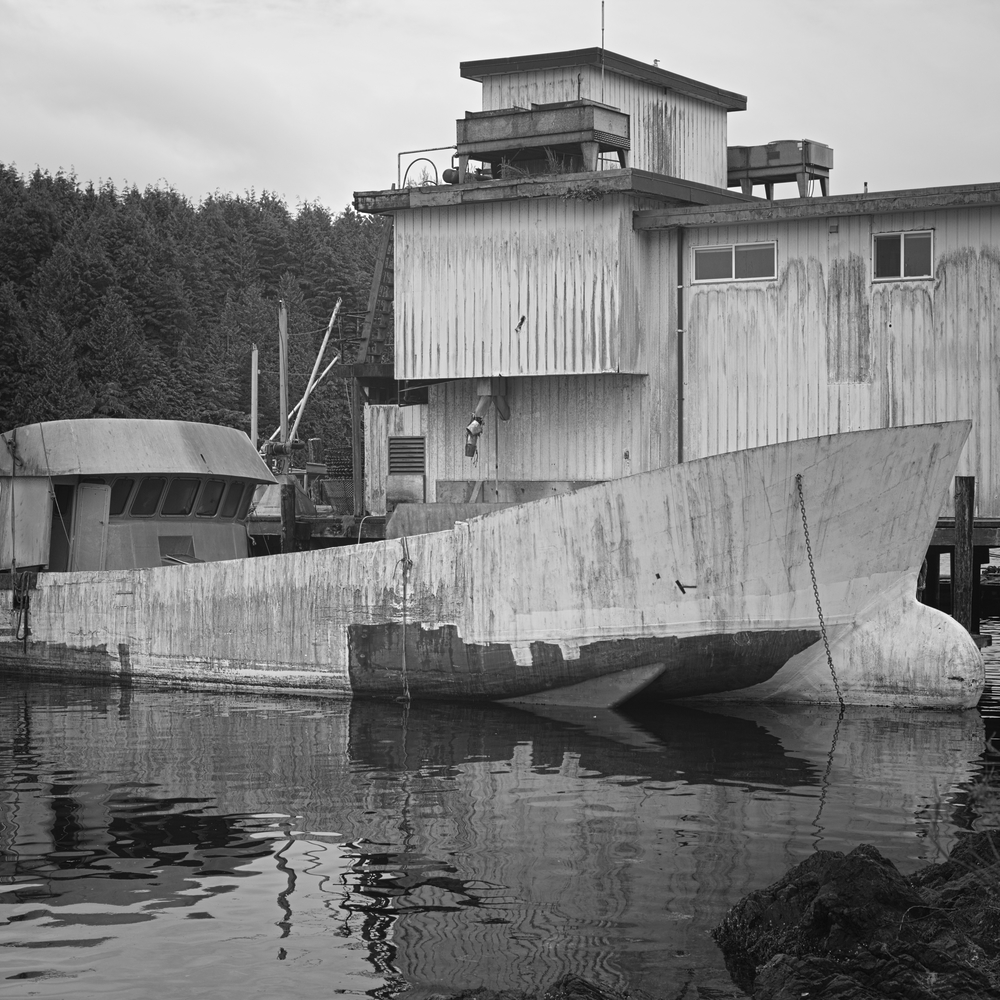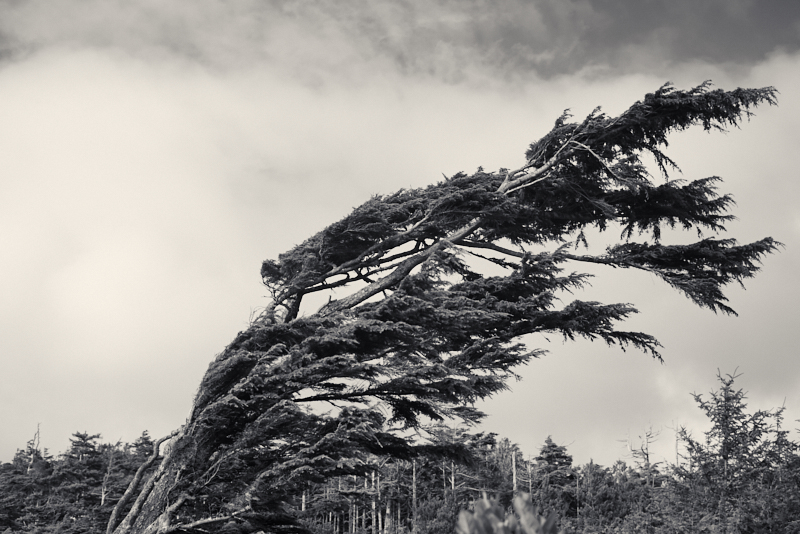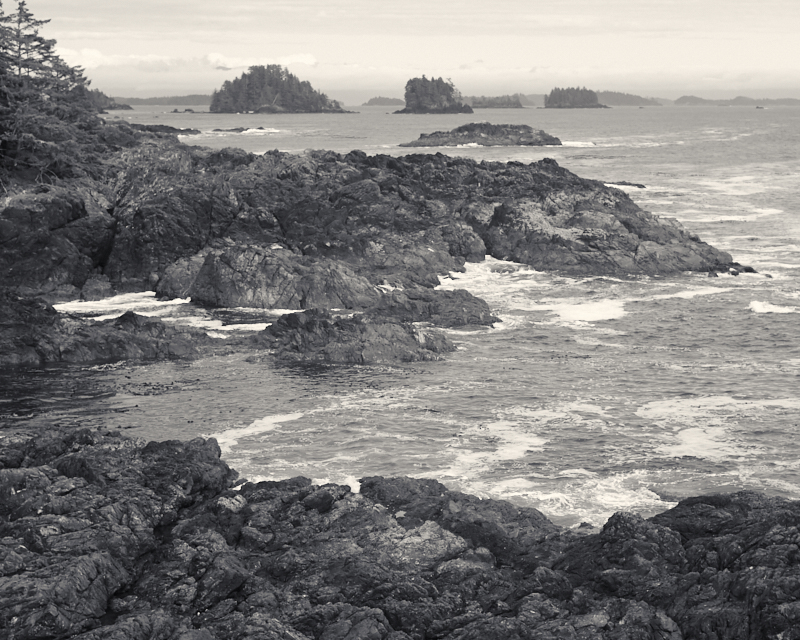The Salish Sojourn X
Ucluelet, British Columbia

Cannery, Ucluelet, BC
An unexpected aspect of life on the Salish Sea is the Olympic rain shadow. Out-of-area visitors might believe the fable that rain is a near-constant in Washington and British Columbia; in fact, there are areas where that is not the case.
Mount Olympus, and the lesser peaks of the Olympic range in Northwestern Washington, create a rain shadow over part of the Salish Sea. As precipitation-laden storms strike land, these mountains force the air to rise and cool. Colder air cannot hold as much moisture, so it condenses and falls as rain. Consequently, the lands to the seaward side of Mount Olympus soak up a significant amount of precipitation. Forks, for instance, receives an average of 118 inches per year, while rain gauges placed on Mount Olympus tell us that as many as 220 inches can fall there in a season. This uplift and condensation leads to a very wet climate on the west side of the mountain range, which has created the Olympic Rainforest.
The leeward side is a very different story. Since so much moisture has been squeezed out of the air by its transit over the high slopes, there is very little available left to provide rainfall. This geographical phenomenon yields a zone of significantly depressed rainfall averages — the rain shadow that hangs over the southern end of the Salish Sea. The center of the zone, and its driest point, sits north of the Washington town of Sequim, south of San Juan Island, and east of Victoria. Here, no more than 13 inches of rain fall every year. This is less than the annual rainfall of Los Angeles (14.93 inches). While not a desert, it is strikingly arid.
Sequim is relatively dry, with an annual total of 16.5 inches; San Juan Island, at the American Camp receives 20.0. Victoria is slightly wetter, with 24 inches falling every year.
These local climatic aberrations can create problems. I noted, for instance, at Snug Harbor, on San Juan Island, signs at the local marina which said they could not provide water for visiting boats — they were experiencing a water shortage and could not afford to deplete their reserves. A placard in the cabin we occupied encouraged us to conserve water: it is a precious resource on San Juan Island.
You wouldn't expect that. The Pacific Northwest is so firmly linked with rain in the popular imagination, that this small zone of permanent drought seems unlikely.
Ucluelet, on the other hand, is well outside of the rain shadow. Lacking an intervening mountain and exposed to the Pacific, the little town outpaces Forks, receiving 132 inches of rain every year. It is the first stop for moisture-laden storms as they sweep ashore. Even though it is the middle of July, three of the four days we have spent here have had rain. Downstairs, in the lobby of the Whiskey Landing Lodge, is a sign designed to console guests: without rain, there would be no rainbows.
Well yes, but I can't say that I have actually seen any rainbows. Plenty of rain, however.
On the other hand, it is not as if we didn't know what to expect. While you might hope for sunshine — and we did have nearly one full day — the reality is that this is the land of rain and wind. The trees and foliage, green from continuous watering bear witness, just as their twisted limbs attest to fierce winds (which we have been spared).

Wind-warped Tree, Ucluelet, BC
Some might consider this a negative, but the people of Long Beach, Ucluelet, and Tofino have managed to rebrand it as an attraction. The resorts along the ocean now do a surprising amount of business in the heart of the winter, capitalizing on the savagery of the Pacific storm season. At this time, when gusts can reach hurricane force, and storms march off the ocean in a seemingly endless parade, the local communities are pitching the region as the premier storm watching site. What could be more romantic than to be sitting in front of a large picture window, watching the wind-flailed waves smash the rocks, releasing geysers of spray? You wouldn't want to go for a walk in such extreme conditions, but it is possible to sit behind a window, cozy and dry, a fireplace warming your toes, the stem of a glass of merlot balanced between your fingers — what could be finer? Evidently the storm tourist season is growing rapidly, with visitors arriving from across the globe to witness the majesty of a winter gale.

Brokeback Boat and Shack, Ucluelet, BC
Rain is also good for the local amphibians: frogs, newts, and salamanders all thrive in the mossy forests. While the climate is ideal, the advent of the motor vehicle has been hard on the little critters. It is another testament to the people of Ucluelet that they have created an organization — S.P.L.A.T. (Society for the Prevention of Little Amphibian Tragedies) — to build amphibian byways beneath the local roads.
Life on the edge. Ucluelet is a mesmerizing place, perhaps the most engaging so far on our trip. While it would take a hardy soul to remain here throughout the year — weathering the 132 inches of rain, and shrugging off the ever-present threat of a tsunami that could sweep you away — the rewards are many: clean air, beautiful country, eagles, bears, cougars. And most importantly, the sense of isolation, of being out of the city, of living on the untamed frontier, where the land ends and the relentless, ever-powerful sea begins.
It is a marvelous town. I am sorry to have to leave.

Life on the Edge, Ucluelet, BC
If you are enjoying this series, why not subscribe to Richard's monthly newsletter, What's New in Old News? The Peripatetic Historian is on the road, roaming the world and compiling fresh adventures. Don't miss out. Click here to join the legions of above-average readers who have already subscribed.